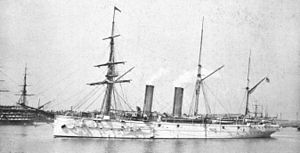HMS Mercury (1878)
 Mercury
| |
| History | |
|---|---|
| Name | Mercury |
| Builder | Pembroke Dockyard |
| Laid down | 16 March 1876 |
| Launched | 17 April 1878 |
| Completed | September 1879 |
| Reclassified |
|
| Fate | Sold for scrap, 9 July 1919 |
| General characteristics | |
| Class and type | Iris-class despatch vessel, later second-class cruiser |
| Displacement | 3,730 long tons (3,790 t) |
| Length | 315 ft (96 m) |
| Beam | 46 ft (14 m) |
| Draught | 20 ft 6 in (6.2 m) |
| Installed power | 12 kW ) |
| Propulsion | 2 × shafts; 2 × compound-expansion steam engines |
| Sail plan | Barque-rigged |
| Speed | 17 knots (31 km/h; 20 mph) |
| Range | 4,950 nmi (9,170 km; 5,700 mi) at 10 knots (19 km/h; 12 mph) |
| Complement | 275 |
| Armament | 10 × 64 pdr rifled muzzle-loading (RML) guns |
HMS Mercury was one of two Iris-class despatch vessels, later redesignated as second class cruiser built for the Royal Navy during the 1870s. The two ships were the first all-steel warships in the Royal Navy.
Design and description
The Iris-class ships were designed as
draught of 20 feet 6 inches (6.2 m). The ships displaced 3,730 long tons (3,790 t) at normal load[1] and were the first British warships with an all-steel hull.[2] Their crew consisted of 275 officers and ratings.[1]
The Iris class was powered by a pair of horizontal four-cylinder
kW) for a speed of 17 knots (31 km/h; 20 mph). Mercury reached a maximum speed of 18.57 knots (34.39 km/h; 21.37 mph) from 7,735 ihp (5,768 kW), making her the fastest warship in the world.[3] The ship carried enough coal to steam 4,950 nautical miles (9,170 km; 5,700 mi) at 10 knots (19 km/h; 12 mph).[1] Originally equipped with a light barque rig, her sails were soon removed and the class became the first "mastless cruisers".[4]
The Iris-class ships were originally armed with ten 64-pounder (6.3-inch (160 mm))
pivot mounts to serve as chase guns fore and aft.[1]
Construction and career
Mercury was
laid down at Pembroke Dockyard on 16 March 1876, launched on 17 April 1878 and completed in September 1879.[3]
Mercury served with the Portsmouth Reserve from 1879 to 1890, in China from 1890 to 1895 and with the Portsmouth Reserve again from 1895 to 1903. She served as a navigation school ship for navigating officers from 1903 to 1905 and a submarine depot ship at Portsmouth from 1906 to 1913, and at
hulked at Rosyth in 1914 with the port depot ship there, HMS Columbine, the former HMS Wild Swan. She was moved to Chatham, where she became an accommodation ship from 7 January 1918, and was paid off in March 1919.[5] She was eventually sold for scrap to the Forth Shipbreaking Company, at Bo'ness, on 9 July 1919.[5]
Notes
Bibliography
- Archibald, E.H.H. (1971). The Metal Fighting Ship in the Royal Navy 1860-1970. Ray Woodward (illust.). New York: Arco Publishing Co. ISBN 0-668-02509-3.
- ISBN 978-1-86176-281-8.
- Gardiner, Robert, ed. (1992). Steam, Steel and Shellfire: The Steam Warship 1815–1905. Conway's History of the Ship. London: Conway Maritime Press. ISBN 1-55750-774-0.
- Lyon, David & Winfield, Rif (2004). The Sail & Steam Navy List: All the Ships of the Royal Navy 1815–1889. London: Chatham Publishing. ISBN 1-86176-032-9.
- Morris, Douglas (1987). Cruisers of the Royal and Commonwealth Navies. Liskeard: Maritime Books. ISBN 0-907771-35-1.
- Roberts, John (1979). "Great Britain". In Gardiner, Robert (ed.). Conway's All the World's Fighting Ships 1860–1905. Greenwich: Conway Maritime Press. ISBN 978-0-907771-73-9.
